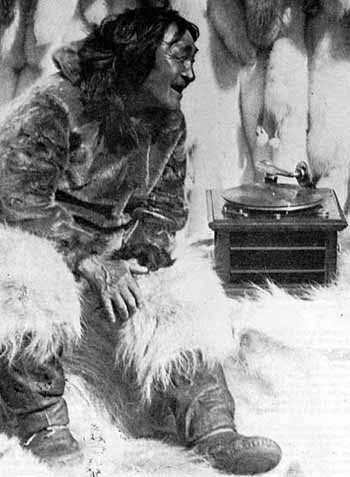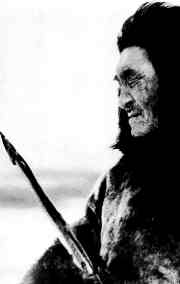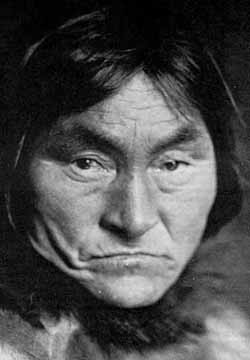|
|
|
|
Eskimo

A general term used to refer to a number of groups inhabiting the coastline from the Bering Sea to Greenland and the Chukchi Peninsula in NE Siberia. A number of distinct groups, based on differences in patterns of resource exploitation, are commonly identified, including Siberian, St. Lawrence Island, Nunivak, Chugach, Nunamiut, North Alaskan, Mackenzie, Copper, Caribou, Netsilik, Iglulik, Baffinland, Labrador, Coastal Labrador, Polar, and East and West Greenland. Since the 1970s Eskimo groups in Canada and Greenland have adopted the name Inuit, although the term has not taken hold in Alaska or Siberia. In spite of regional differences, Eskimo groups are surprisingly uniform in language, physical type, and culture, and, as a group, are distinct in these traits from all neighbors. They speak dialects of the same language, Eskimo, which is a major branch of the Eskimo-Aleut family of languages. Their antiquity is unknown, but it is generally agreed that they were relatively recent migrants to the Americas from NE Asia, spreading from west to east over the course of the past 5,000 years.
The Eskimos are the most widely dispersed group in the world still leading a partly aboriginal way of life. They live in a region that spans more than 3,500 miles, including Greenland, the northern fringe of North America, and a sector of eastern Siberia.
Eskimos are racially distinct from American Indians, and are not, as previously believed, merely Indians transformed. In fact, the Eskimos are most closely related to the Mongolian peoples of eastern Asia. Eskimos consider themselves to be Inuit (The People). The Eskimo-Aleut languages are unrelated to any American Indian language groups.
The Eskimo population was approximately 50,000 at the time of the first widespread contact with Europeans. An estimated 2,000 Siberian Eskimos lived near the Bering Strait, the Alaskan Eskimos numbered about 25,000, and the Central Eskimos (who inhabited what is now northern Canada) numbered about 10,000. The Labrador Eskimos totaled about 3,000, while the Greenland Eskimos totaled about 10,000.
The popular conception of the Eskimoswhale hunters dressed in heavy fur clothing and living in dome-shaped ice lodgesis derived from the Eskimos who live farthest north, on the Arctic islands of Canada and along northwestern Greenland. In reality, these northern Arctic dwellers formed a minority among Eskimos as a whole. No single environmental adaptation existed throughout the area of Eskimo occupancy. Eskimos along the Pacific coast probably obtained much of their food by fishing for salmon, while the Central Eskimos of Canada subsisted mainly on caribou. Eskimo groups lived in various types of shelters, including semi-subterranean sod houses and tents made of caribou skins.
At no time did the Eskimos possess a national or even well-defined tribal sense. The emphasis was on the local and familial group rather than on associations of land and territory.
The overall Eskimo population has remained fairly constant over the past several centuries, although not all groups have remained stable in number. According to the 1990 census, there are 57,152 Eskimos and 23,797 Aleuts living in the United States. Eskimo Culture
Particularly when compared to other hunting and gathering populations, Eskimo groups are justly famous for elaborate technologies, artisanship, and well-developed art. They live in small bands, in voluntary association under a leader recognized for his ability to provide for the group. Only the most personal property is considered private; any equipment reverts through disuse to those who have need for it. In the traditional Eskimo economy, the division of labor between the sexes was strict; men constructed homes and hunted, while the women took care of the homes. Their religion is imbued with a rich mythology, and shamanism has been practiced. The native food supply has been reduced through the use of firearms, but, as a result of increased contact with other cultures, the Eskimo are no longer completely dependent on their traditional sources of sustenance. The present Eskimo population is approximately 60,000, with about 10,000 in Greenland, 29,000 in Alaska, 19,000 in Canada, and 2,000 in Siberia. Eskimo Life
Most groups rely on sea mammals for food, illumination, cooking oil, tools, and weapons. Fish and caribou are next in importance in their economy. The practice of eating raw meat, disapproved of by their Native American neighbors, saves scarce fuel and provides their limited diet with essential nutritional elements that cooking would destroy. Except for the Caribou Eskimo of central Canada, they are a littoral people who rove inland in the summer for freshwater fishing and game hunting. Eskimos have various types of houses. Tents of caribou skins or sealskins provide adequate summer dwellings; in colder seasons shelter is constructed of sod, driftwood, or sometimes stone, placed over excavated floors. Among some Eskimo groups the snow hut is used as a winter residence. More commonly, however, such structures may be used as temporary overnight shelters during journeys. The dogsled is used for the hauling of heavy loads over long distances, made necessary by the Eskimo's nomadic hunting life. Their skin canoe, known as a kayak, is one of the most highly maneuverable small craft ever constructed. Hunting technologies include several types of harpoons, the bow and arrow, knives, and fish spears and weirs. While iron has come into common use in the 20th cent., previously weapons were crafted from ivory, bone, copper, or stone. Their clothing is sewn largely of caribou hide and includes parkas, breeches, mittens, snow goggles, and boots. Finely crafted items such as needles, combs, awls, figurines, and decorative carvings on weapons are executed with the rotary bow drill. See Ulli Steltzer, Inuit: The North in Transition (1985); Asen Balikci, The Netsilik Eskimo (1989). Eskimo-Aleut The family of Native American languages consisting of Aleut (spoken on the Aleutian Islands and the Kodiak Peninsula) and Eskimo (spoken in Alaska, Canada, Greenland, and Siberia). Aleut is the language of fewer than one thousand people, and Eskimo is native to almost 100,000 people. There are a few varieties of the Eskimo language. Eskimo and Aleut have enough similarities to justify the theory that they are descendants of a single ancestor language. A striking and important feature of both tongues is polysynthesism. In a polysynthetic language, a one-word unit composed of a number of word elements can convey the meaning of an entire sentence in an Indo-European language. Eskimo and Aleut make great use of suffixes, but almost never of prefixes. Internal vowel changes are rare. Both languages are highly inflected. The difference between transitive and intransitive verbs is clearly shown. Three numbers are foundsingular, dual, and plural. Phonetically, there are three main vowels in Eskimo, and from 13 to 20 consonants, the number varying according to the dialect. In earlier times the Eskimos had only pictographic writing. Since the 18th cent., however, the Eskimos of Greenland, Labrador, and Alaska have used an adaptation of the Roman alphabet, introduced by missionaries. The Eskimos of modern Siberia and the Aleut-speaking groups employ the Cyrillic alphabet. See Knut Bergslund, A Grammatical Outline of the Eskimo Language of West Greenland (1955) and Aleut Dialects of Atha and Attu (1959); L. L. Hammerich, The Eskimo Language (1970); Michael E. Krauss, Alaskan Native Languages (1980).
Nanook Of The North




"Mom, We've Been Discovered"
Excerpts from what appears to be a very interesting book by a member of the
Dene Nation. The thumbnail photos enlarge quickly with a click.
http://www.nlc-bnc.ca/north/nor-ii/polar/pol-037e.htm
Alaska Native Knowledge Network
Alaskan natives have a wealth of knowledge garnered over thousands of years
of existence. This Network is trying to integrate that knowledge and their
old ways of education with the Western way. The "Sharing the Pathways"
newsletters are full of excellent articles. You'll need the Acrobat Reader
to view/download the available brochure which is a .pdf file. The
Culturally-Based Curriculum Resources page will be of benefit to educators
everywhere.
http://www.ankn.uaf.edu/
Aleut Culture
"Before 1741, the year Vitus Bering 'discovered' Alaska, it has been
estimated by historians that the Aleut population was at least at about
16,000 people." How did these people survive without "modern" technologies
and conveniences in this unforgiving climate? This site has the answers.
http://www.aleutcorp.com/culture/
Arctic Circle
Comprehensive site, dealing with issues concerning
indigenous peoples, focusing mainly on Alaskan natives but with articles
about other circumpolar groups. Leave yourself plenty of time for this large
website.
http://borealis.lib.uconn.edu/ArcticCircle/
Mistissini Cree
Take the guided tour offered you on this attractive site. There's a map, a
timeline for the region and its inhabitants, cultural information, and links
to tourism and related websites.
http://nation.mistissini.qc.ca/
Old Crow - Land of the Vuntut Gwitch'in
View this site in either French or English to access information about what
life is like for the Vuntut Gwitch'in people who live 112 km (70 miles)
north of the Arctic Circle. There is one section which stresses the
importance of the caribou to this community.
http://collections.ic.gc.ca/old_crow/index.html
Ouj-Bougoumou:
Look through all the areas of this attractive 55-page website. The history
section is the place to see how non-native enterprises, like mining and
logging, can affect Native peoples. Learn how this community is pulling
together to educate their people and promote self-reliance. Read the list of
items to be found in a medicine bag, and find out how they are used. The
site cover such a wide range of topics! Allow time to see it all.
http://ouje.ca/
Quebec's Northern Crees
You'll find pictures, information on history, language, culture, and past
and recent political issues.
http://www.lib.uconn.edu/ArcticCircle/CulturalViability/Cree/
We Are the Eskimo People
There are videos -- Native Dancing, Whaling Crew, Basket Making, Summertime
on the Chukchi Sea -- and the page referred to in the title is now found by
clicking on the link to "Stories" (at top, far left). Read the other
true-life stories, too. You'll get a good idea of how your life differs from
that of the Inupiat people of Point Hope, Alaska. (Follow the link to
download the free Real Player -- you'll need it to view the videos and hear
the audio files.)
http://www.chukchi.com/index.html
Welcome from Chief Abel Bosum
A plain-spoken, disturbing look at the modern history of the Ouje-Bougoumou
Cree nation. You get a feeling through first-hand accounts from elders of
what life is like for natives whose homelands were rich in mining and
forestry resources.
http://www.ouje.ca/welcome/chief.htm
Yup'ik Eskimo Subsistence
"Describes the Yup'ik Eskimo and their land and, along with
the James H. Barker photographs, documents their annual subsistence cycle."
[James J. Reca]
http://mcclungmuseum.utk.edu/specex/yupik/yupik.htm
Innuit
Arctic Cyber Anthropology - http://home.worldonline.dk/~nbc/
Research project "Inuit in Cyberspace" by Neil Blair Christensen, Dept. of Eskimology, University of Copenhagen. It has a substantial amount of annotated and categorized links (400+) for the circumpolar Arctic.
Avataq Cultural Institute - http://www.avataq.qc.ca
Non-profit organisation created by the Inuit of Nunavik (Labrador peninsula) to protect and promote their traditional culture. The programmes include archaeology, oral history, place names, genealogy, etc. The site also present a sample of the Inuit art collection that was donated to the Institute by the Department of Indian Affairs and the North, Canada.
Cape Dorset Inuit Art and Inuit Cultural Perspectives - http://collections.ic.gc.ca/cape_dorset/index1.html
Links the graphic work of some of the famous artists from the community of Cape Dorset with the memories, myths and legends of elders from the community of Igloolik.
Inuit Art Foundation - http://www.inuitart.org/
A non-profit organization owned and controlled by Canadian Inuit (Eskimo) artists, by providing professional development opportunities for artists and promoting Inuit art worldwide. Contains information on the Inuit Art Quarterly magazine, the Inuit Artists' Shop in Ottawa and the Inuit Artists' College.
Inuit Business Directory - http://inuit.pail.ca/
A national directory maintained by the Pan Arctic Inuit Logistics Corporation, listing only Inuit-run businesses in Canada.
Inuit Tapirisat of Canada - http://www.tapirisat.ca/
Information about ITC's role in political, cultural and economic development of the Inuit of Canada. In-depth description of their history, culture, territory. Includes maps and visuals.
Inuktitut-The Language of the Inuit People - http://www.arctic.ca/LUS/Inuktitut.html
Maintained by the Leo Ussak Elementary School in Rankin Inlet, Nunavut, Canada. Includes lessons on names of communities of Baffin Island and how to write in syllabics.
Inupiaq Studies Curriculum - http://www.alaskool.org/native_ed/curriculum/nwabsd1/nwabsd_inupiaq.html
Example of integration of Inuit issues in the school, in Alaska (Inupiaq: North Alaskan Inuit)
Inupiaq - Cultural Profile - http://www.nnlm.nlm.nih.gov/pnr/ethnomed/inupiaq.html
Information by The University of Washington about the traditional medicine of the North Alaskan Inuit or Inupiaq people.
Iupiaq Cultural Resources - http://www.ankn.uaf.edu/inupiaq.html
Information on the North Alaskan Inuit or Inupiaq people, maintained by the Alaska Native Knowledge Network (ANKN).
Kitikmeot Inuit Association - http://www.polarnet.ca/polarnet/kia.htm
An organization to defend, preserve and promote social, cultural and economic benefits to Inuit of the Kitikmeot Region of Nunavut.
Native Broadcasting - http://www.cancom.ca/english/natives/
The story of native broadcasting in northern Canada, drawn from extensive interviews conducted by Elaine Shorty, during her Ross Charles Awards internship at Cancom.
North - Landscape of the Imagination - http://www.nlc-bnc.ca/north/norint-e.htm
A history of the Canadian North and its influences on the Arts of its residents and outsiders, from the pre-contact period up to the modern era. Compiled by the National Library of Canada, with extensive lists for suggested reading.
Nunacom Font Information - http://www.nunavut.com/technology/english/download.html
Nunacom is a 7-bit font designed for reading Inuktitut syllabic web pages for both Windows and Mac computers. Site has a keyboard layout and character combination chart for accurate placement of diacritics, and installation instructions for the TrueType font, which may be downloaded for free.
Nunavut Tunngavik - http://www.tunngavik.com/
Promoting the development of Inuit economic self-sufficiency and prosperity through responsible management of Inuit owned lands and resources, and through promotion of and support to Inuit business in Nunavut.
Place names in Inuktitut - http://www.geocities.com/Athens/9479/inuit.html
Original Inuit forms of places in Greenland (now official in Inuktitut) and Canada (in Nunavut and else), from the site GeoNative.
Qikiqtani Inuit Association - http://www.nunanet.com/~lands/
A non-profit organization, representing the Inuit of Baffin Island, Canada.
Satuumavik School - http://www3.sympatico.ca/satuumavik/
Serving the Inuit community in Kangiqsualujjuaq, in the Nunavik region of Northern Qubec. School projects and events, and a profile of community life created by the grades 4 and 5 classes.
School Tools - Inuit - http://www.gov.nt.ca/kids/school/p-inuit.htm
Information for school children about the Inuit people, provided by the Government of the Northwest Territories.
The Arctic String Figure Project - http://www.isfa.org/arctic.htm
A collection of well-illustrated detailed instructions on how to make string figures, based on original descriptions of traditional figures collected by researchers in the Arctic. Of particular interest is a series of 100 figures collected by Diamond Jenness, in 1924.
Tuktu and Nogak Project - http://aulak.polarnet.ca/tuktu/
A community-driven effort to collect and share Inuit ecological knowledge of caribou and calving areas in the Bathurst Inlet area of the Kitikmeot region, Nunavut, Canada. The site has a photo gallery, a report on the Elder-Youth Camp on the Hiuqqittaaq River, and a list of the interviewees.
|
|
|
|
|
|
 Native American Nations
Native American Nations
